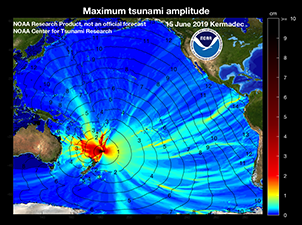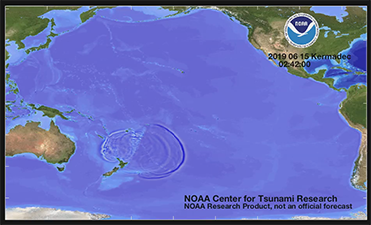Not an official forecast
Kermadec Tsunami, June 15, 2019
Main Event Page
|
This Kermadec tsunami was generated by a Mw 7.2 earthquake (30.805°S 178.095°W), at 2019-06-15 22:55:02 UTC (according to the USGS). A small tsunami was observed seventeen minutes after the earthquake at the nearby tide gauge of Raoul Island Boat Cove, New Zealand, with the leading tsunami wave amplitude of 5 cm . The first wave peak of the tsunami at deep-ocean station DART 51426, located 1,300 km northeast from the epicenter, was detected about 1.5 hours after the earthquake. Model results shown below were created with the NOAA forecast method using the MOST model that include quick forecast assessment using the first USGS estimate of the Moment Tensor solution (Mw 7.2) published 37 minutes after the earthquake. The graphics display preliminary modeling analysis, showing qualitative and quantitative information about the tsunami, including tsunami wave interaction with ocean floor bathymetric features, and neighboring coastlines. Tsunami model amplitude information is shown colored according to the scale bar.
DART® comparisons with model data Tide gauge comparisons with model data: Raoul Island, Great Barrier Island, and East Cape, New Zealand. It is noted that all above model results are preliminary. The discrepancies between model results and tide gauge observations are mostly due to our limited knowledge of the earthquake/tsunami source configuration and uncertainties of the local bathymetry around tide gages. Tide gauge comparisons with model data Comparison of the June 15, 2019 New Zealand tsunami recorded at the tsunameter (DART buoy) and tide gauges with model results. The wave propagation and local model around tide-gage resulting from the CMT-based source was computed on the fly while the tsunami was still progressing. |
||||
Disclaimer: The models on these pages show the results of ongoing research to enhance tsunami science and to improve NOAA operational tsunami forecasts. These products were developed during or shortly after the tsunami event, are intended for research use, and are not an official forecast. They should not be used as the basis of any public or private policy decisions. Please contact NCTR to find if there are more detailed follow-on analysis results.
For media inquiries:
When using information from this page, please credit NOAA / PMEL / Center for Tsunami Research


